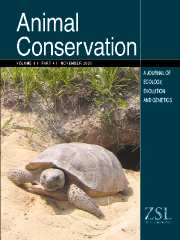Article contents
Culling and the dynamics of the Kruger National Park African elephant population
Published online by Cambridge University Press: 01 November 1999
Abstract
South Africa's National Parks Board has opted to control African elephants (Loxodonta africana) through culling in the Kruger National Park (KNP). Killing elephants is highly controversial. The Board must balance this controversy against the probable destruction of vegetation and the consequent depletion of biological diversity that high elephant densities cause. Annual aerial counts provided the population estimates on which the culling quotas were based. For management purposes, the elephant population of the Park is divided into four sub-populations. From 1984 to 1994, the annual quota was usually taken from only one of these sub-populations during a given year. This resulted in 3 to 5 years elapsing between culls in each sub-population. We investigated the year-to-year changes in densities after culling. These changes were density dependent. Density dependence implies that immediate culls following estimated high densities may be premature. If left alone, the densities would decline naturally. Indeed, culling becomes self-reinforcing as it moves population densities towards the level where reproduction is greatest. Data confirm this intuition: at densities greater than 0.37 elephants/km2 elephant numbers generally declined without culling. Many culls were unnecessary. Culling, as implemented in the past, may have had consequences for elephants and their habitat that were different to those expected from a mere reduction in their numbers. Densities in the year immediately after a cull tended to decline – not increase as would be expected from density dependence alone. Undoubtedly, this unexpected decline was the consequence of disturbance and subsequent emigration. In following years, the densities rose as animals moved back into the sub-population. A management programme where culling will be instituted only when densities exceed 0.37 elephants/km2 in selected regions in the park for at least 1 year, may be more acceptable than the programme used up to 1995. However, we do not know if the vegetation of KNP can withstand the resulting episodic high densities. With densities presently exceeding the cut-off values calculated for both the south and the northern management regions vegetation changes there need to be monitored.
- Type
- Research Article
- Information
- Copyright
- © 1999 The Zoological Society of London
- 73
- Cited by


